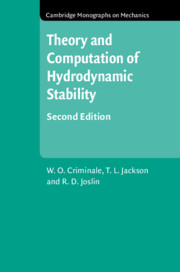3653 results in ebooks in fluid mechanics
2 - Temporal Stability of Inviscid Incompressible Flows
-
- Book:
- Theory and Computation in Hydrodynamic Stability
- Published online:
- 22 November 2018
- Print publication:
- 06 December 2018, pp 26-75
-
- Chapter
- Export citation

Theory and Computation in Hydrodynamic Stability
-
- Published online:
- 22 November 2018
- Print publication:
- 06 December 2018
11 - Propagating Transformations of State in Self-Organizing Systems
-
- Book:
- Impact Mechanics
- Published online:
- 19 October 2018
- Print publication:
- 15 November 2018, pp 264-292
-
- Chapter
- Export citation
Index
-
- Book:
- Impact Mechanics
- Published online:
- 19 October 2018
- Print publication:
- 15 November 2018, pp 353-362
-
- Chapter
- Export citation
References
-
- Book:
- Impact Mechanics
- Published online:
- 19 October 2018
- Print publication:
- 15 November 2018, pp 344-352
-
- Chapter
- Export citation
Permissions
-
- Book:
- Impact Mechanics
- Published online:
- 19 October 2018
- Print publication:
- 15 November 2018, pp 342-343
-
- Chapter
- Export citation
Preface to Second Edition
-
- Book:
- Impact Mechanics
- Published online:
- 19 October 2018
- Print publication:
- 15 November 2018, pp xi-xii
-
- Chapter
- Export citation
Contents
-
- Book:
- Impact Mechanics
- Published online:
- 19 October 2018
- Print publication:
- 15 November 2018, pp vii-x
-
- Chapter
- Export citation
10 - Impact against Flexible Structures
-
- Book:
- Impact Mechanics
- Published online:
- 19 October 2018
- Print publication:
- 15 November 2018, pp 246-263
-
- Chapter
- Export citation
2 - Collinear Rigid Body Impact
-
- Book:
- Impact Mechanics
- Published online:
- 19 October 2018
- Print publication:
- 15 November 2018, pp 21-34
-
- Chapter
- Export citation
8 - Generalized Impact Analysis of Multibody Systems
-
- Book:
- Impact Mechanics
- Published online:
- 19 October 2018
- Print publication:
- 15 November 2018, pp 177-224
-
- Chapter
- Export citation
Appendix A - Role of Impact in Development of Mechanics during the Seventeenth and Eighteenth Centuries
-
- Book:
- Impact Mechanics
- Published online:
- 19 October 2018
- Print publication:
- 15 November 2018, pp 317-335
-
- Chapter
- Export citation
Answers to Some Problems
-
- Book:
- Impact Mechanics
- Published online:
- 19 October 2018
- Print publication:
- 15 November 2018, pp 339-341
-
- Chapter
- Export citation
Appendices
-
- Book:
- Impact Mechanics
- Published online:
- 19 October 2018
- Print publication:
- 15 November 2018, pp 317-338
-
- Chapter
- Export citation
Symbols
-
- Book:
- Impact Mechanics
- Published online:
- 19 October 2018
- Print publication:
- 15 November 2018, pp xvii-xx
-
- Chapter
- Export citation
3 - Planar or Two-Dimensional Rigid Body Impact
-
- Book:
- Impact Mechanics
- Published online:
- 19 October 2018
- Print publication:
- 15 November 2018, pp 35-64
-
- Chapter
- Export citation
Preface to First Edition
-
- Book:
- Impact Mechanics
- Published online:
- 19 October 2018
- Print publication:
- 15 November 2018, pp xiii-xv
-
- Chapter
- Export citation
5 - Tangential Compliance in Planar Impact of Rough Bodies
-
- Book:
- Impact Mechanics
- Published online:
- 19 October 2018
- Print publication:
- 15 November 2018, pp 89-115
-
- Chapter
- Export citation
6 - Continuum Modeling for Local Deformation Near Contact Area
-
- Book:
- Impact Mechanics
- Published online:
- 19 October 2018
- Print publication:
- 15 November 2018, pp 116-147
-
- Chapter
- Export citation
9 - Viscoelastic or Viscoplastic Impact
-
- Book:
- Impact Mechanics
- Published online:
- 19 October 2018
- Print publication:
- 15 November 2018, pp 225-245
-
- Chapter
- Export citation
